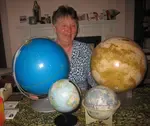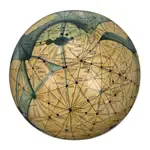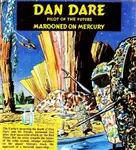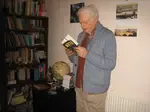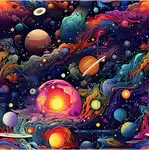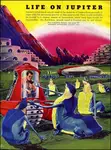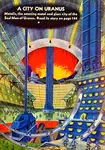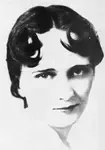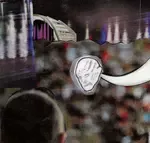what to see on
neptune
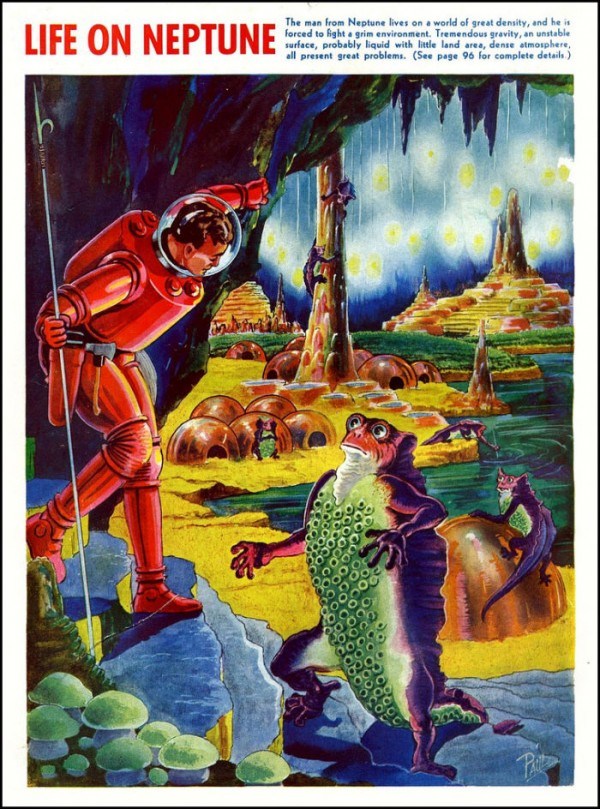
A scenic browse, and an answer-page for Guess The World....
looking around cautiously on neptune
...On the side of the planet away from the sun where they had expected to find darkness, they were astonished to find very little points of light. Dana was puzzled and at a complete loss to explain it.
At last, on the shore of a great, placid lake they found a wide clearing. Something had happened to leave it almost devoid of vegetation as far as they could see. There were rocky pinnacles and great rolling hills of solid rock. Near the edge of the jungle a shallow river meandered among the hills and emptied into the lake. Beyond the river the gullies gradually merged with the hill tops to form a plateau.
Dana lowered the ship and settled it gently upon the top of a low hill beyond the river.
"Let's get out here and look around," he suggested. "We'd better take that little machine gun along; or maybe better, the portable death ray."
Henrik Dahl Juve, The Monsters of Neptune (Wonder Stories Quarterly, Summer 1930)
and see Neptunian Allure
on the neptunian ocean
...Vasc Avam, steering their long, tubular craft, turned his green face worriedly from the wheel.
"We'll have to run beneath surface or these waves will smash us to pieces!" the Jovian mine-boss exclaimed.
"Go ahead - but keep right after Orr Libro's boat," Carson Brand directed.
The Martian's craft was also submerging, ahead. Vasc Avam shifted the control of the deflecting rudders and their own boat slid down and throbbed along twenty feet under the surface.
Captain Future, deep in thought, looked out through the transparent wall of their craft at the lightning-lit waters they were travelling through. Each violet glare showed the teeming life of the sea about them.
Shoals
of brilliant, sparkling "diamond-fish" flashed away, like living gems.
"Air-fish", those weird winged creatures that could live with equal
ease in the air or in the sea, flew away in startled undersea flight...
Edmond Hamilton, Captain Future's Challenge (1940, 1967)
a deserted city on neptune
...a tenseness held all of us as our great flier's faceted polyhedron dropped on through the pale light beneath the great roof toward the black-walled, chequer-board like city that stretched across the surface of the great world beneath us. And now, as we sank lower, our eyes were making out ever more clearly the details of that amazing city.
The
rectangular black-walled compartments held, as we had half-realized
from above, various strange-shaped mechanisms and objects which we could
even now only vaguely discern. We could see clearly, though, that here
and there across all the vast city's compartmented surface there stood
giant metal globes, each a hundred feet in diameter and each occupying a
square compartment of its own. There seemed hundreds of these gleaming
globes, scattered here and there in compartments across the city's
surface as far as we could see...
Edmond Hamilton, The Universe Wreckers (Amazing Stories, May-July 1930)
the lamp-lit fields of neptune
...The clouds had passed and a golden glory was settling over the face of the countryside. While we stared, wondering how this could possibly be, we saw what perhaps we had overlooked before. Set at intervals about the countryside were great many-faceted concave mirrors. At least that was what they looked like to us. Each was set on a vast straddle of lattice-like girders, and each, from the slight movements we saw as we watched, seemed capable of sweeping the full circumference of the sky.
But that was not all. Between each pair of mirrors was another lattice-like structure, bearing at its top a great, glowing golden ball, a thing so huge and so brilliant that its size stunned us and the upthrust of its rays almost blinded us.
"Artificial suns," said someone in an awed tone. "They've solved the secret of atomic energy!"
J M Walsh, The Vanguard To Neptune (Wonder Stories Quarterly, Spring 1932)
blue cetaceans in neptune's ocean
Excerpt from Professor Diego Kraken’s The Cetacean Myths of Neptune:
Once upon a time, there was a pod of Neptunian porpoises that lived outside the deep sea crevice called The Great Depths. Now, Neptune is very far from the sun, and is covered almost entirely in water. Life there has developed differently. The main source of heat energy on Neptune is its enormous molten core which bubbles up here and there in vents. Chemosynthetic bacteria cleave to these vents and so do ecological producers who transform the heat and oxygen dissolved in the water into what we may as well call plants, or more precisely seaweed. Fish feed on these plants, and plankton feeds on the bacteria. The convection of the hot water rising brings the plankton towards the surface, and the fourteen moons of Neptune make waves that mix in oxygen. Life on Neptune tends to cluster around deep sea crevices, because that is where the source of life emerges. And so, like everywhere else in the solar system, life abounds.
Neptunian porpoises look just like Earth porpoises except they are a little bigger and appear purple to our eyes. They catch fish and also need to come up to the surface to breathe air…
Violet Bertelsen, The Lure of the Depths (Vintage Worlds 1, ed. J M Greer and Zendexor, 2018)
>> Guess The World - Third Series
men re-evolve on far-future neptune
…Now in the fullness of time, about three hundred million terrestrial years after the solar collision, a certain minute, hairless, rabbit-like creature, scampering on the polar grasslands, found itself greatly persecuted by a swift hound from the south. The subhuman rabbit was relatively unspecialized, and had no effective means of defence or flight. It was almost exterminated. A few individuals, however, saved themselves by taking to the dense and thick-trunked scrub, whither the hound could not follow them. Here they had to change their diet and manner of life, deserting grass for roots, berries, and even worms and beetles. Their forelimbs were now increasingly used for digging and climbing, and eventually for weaving nests of stick and straw. In this species the fingers had never grown together. Internally, the forepaw was like a minute clenched fist from the elongated and exposed knuckles of which separate toes protruded. And now the knuckles elongated themselves still further, becoming in time a new set of fingers. Within the palm of the new little monkey-hand there still remained traces of man’s ancient fingers, bent in upon themselves.
As of old, manipulation gave rise to clearer percipience. And this, in conjunction with the necessity of frequent experiments in diet, hunting, and defence, produced at length a real versatility of behaviour and suppleness of mind. The rabbit throve, adopted an almost upright gait, and continued to increase in stature and in brain. Yet, just as the new hand was not merely a resurrection of the old hand, so the new regions of the brain were no mere revival of the atrophied human cerebrum, but a new organ, which overlaid and swallowed up that ancient relic. The creature’s mind, therefore, was in many respects a new mind, though moulded to the same great basic needs. Like his fore-runners, of course, he craved food, love, glory, companionship. In pursuit of these ends he devised weapons and traps, and built wicker villages. He held pow-wows. He became the Tenth Men.
Olaf Stapledon, Last And First Men (1930)
>> Guess The World - Third Series
the swaying mountains of neptune
When the Venjisk
had descended to within a couple of yards of the surface, the order was
given to lower the land-anchors: wired weights which could, at a
signal, fire oblique prongs into soil or rock; but since the wind
was scant and the ship thus unlikely to drift at its mooring, Captain
Tarven Namaksa deemed it safest to stabilise by weight alone, rather
than risk what might ensue from piercing this terrain.
For
a similar reason, when he appeared at the exit hatch his right hand
gripped a ceremonial sword rather than an energy or projectile weapon.
If necessary he could draw laser, but only as a last resort. Where
possible, ground-damage should be avoided amidst the Wobbly Mountains.
A rope ladder was paid out and he descended to the surface, followed by a dozen guards and investigators selected from the crew, including Interrogator Eyol Mnand - all provided with swords which they carried with varying degrees of self-consciousness.
Then,
having disembarked the captain and his party, the airship rose again,
to an altitude of about seventy yards, from which the First Officer,
Oren Xecal, could hope to stand sentinel against all comers.
Meanwhile the grounded personnel formed a circle, facing every way, watching out for signs of unusual movement. The bowl-shaped depression in which they stood was a land of silence except for the barely audible creak of the swaying mountains...
Robert Gibson, Outlaws of Neptune
>> Guess The World - Third Series
shooting a movie on neptune
…the Perseus began to navigate cautiously above the weird forests of the ocean floor, moving in widening circles. The muffled throbbing of the baffled rockets was loud in their ears.
“We’re looking for a city of the sea-folk,” Jim Willard explained. “There’s supposed to be one in this region.”
“What if they don’t like the idea of our visiting them to make scenes?” asked Jon Valdane doubtfully.
“They’ll be all right,” said Davis. “They’re not exactly human, but they’re semi-civilized and friendly now.”
The lights caught two monstrous ursals engaged in a ferocious underwater struggle. Then as the two creatures separated and fled from the brilliance, a sharp cry came from the bridge-room.
“Submarine city two miles ahead.”
A moment later, the bow-rockets blasted and then the Perseus sank downward toward an open glade in the weird polyp-forest.
They all strained their gaze ahead in an endeavour to make out the outlines of the submarine city. But only a dim glimpse came to their watching eyes through the dusky water of a distant mass of black, cubical buildings surrounding a central pyramid…
Edmond Hamilton, Magic Moon (Captain Future, Winter 1944)
>> Guess The World - Third Series
yellow-violet jungle on neptune
…Although the king cared nothing for their ceremonies, he was uneasy. Seldom it was that Dutch anticipated trouble, but the odds against him were so stupendous that he dared not but follow his subjects. Since there was nothing left of his palace equipment, he turned toward the jungle and followed the victorious army. He crossed the stream and then wound around the hills until he came to the great tangle of yellow-violet trees and vines. So dense was the growth that the natives maintained tunnels through the dripping mass. The king selected one of the tunnels into which the army had disappeared, and plunged after in pursuit.
Had this jungle been on the earth, the interior of the tunnel would have been dark as night, but here the light came up from the ground, thus maintaining a uniform intensity of illumination that was equal to that of the plain.
The path had been churned by countless feet into a thin, creamy mud in which the king waded ankle deep. But it was this same disagreeable mud which guided him through the maze of tunnels and cross passages, for the sides of the recently used course were newly splashed with dripping mud. Occasionally he heard the bellow of warriors deep in the jungle but so far in advance were they that it was only the louder sounds that reached him.
For three “sleeps” the king penetrated deeper and deeper into the mysterious jungle…
Henrik Dahl Juve, The Struggle for Neptune (Wonder Stories Quarterly, Fall 1930)
>> Guess The World - Fourth Series
See also Neptunian Allure.
reversed time-stream on neptune
…The planet had been out of bounds ever since those geodetic expeditions had set out for Neptune over two centuries ago – and never come back. Early space patrols and search parties had been sent into that part of the celestrial sphere – only to disappear forever. The planet had become a symbol of the terrifying unknown. Eventually it was forbidden by interplanetary law to stray beyond the orbit of Uranus.
But why? There must be reasons for those disappearances. Who could resist an invitation like that?
“Some day,” they said. “Some day. All in good time.”
Now was as good a time as any.
…A good-sized city. No more than a mile away. Darrel glanced back at the ship from the hilltop, shrugged and turned toward the city.
When he reached it he found a nightmare world.
These Neptunians were all crazy. Disregarding every natural law, they dashed about the streets backward. Every last one of them. And they stared at him as though he were a freak!
Henry Guth, Planet in Reverse (Planet Stories, Spring 1948)
>> Guess The World - Fourth Series
neptune in the twilight of man
…We landed on Neptune. M’reen was the city. Large as the Yawk City of my own day – and no one living there.
The planet was cold and dark – horribly cold. The sun was a tiny, pale disk, heatless and almost lightness. But the city was perfectly comfortable. The air was fresh and cool, moist with the scent of growing blossoms, perfumed with them. And the whole giant metal framework trembled just slightly with the humming, powerful beat of the mighty machines that had made and cared for it.
I learned from records I deciphered, because of my knowledge of the ancient tongue that their tongue was based on, and the tongue of that day when man was dying, that the city was built three million, seven hundred and thirty thousand, one hundred and fifty years after my birth. Not a machine had been touched by the hand of man since that day.
Yet the air was perfect for man. And the warm, rose-silver glow hung in the air here and supplied the only illumination.
I visited some of their other cities where there were men. And there, on the retreating outskirts of man’s domain, I first heard the Song of Longings, as I called it.
And another, The Song of Forgotten Memories…
John W Campbell, Twilight (Astounding, November 1934)
>> Guess The World - Fourth Series
artificial mountain on neptune
…Almost the first moments of that day of recreation afforded me one of those pictures which haunt the memory ever after. The sun had risen over a burning ocean. He was not, as you might expect in our remote world, a small and feeble sun; for between your age and ours a collision had increased his bulk and splendour to a magnitude somewhat greater than that with which you are familiar.
Overhead the sky was blue. But for Neptunian eyes its deep azure was infused with another unique primary colour, which your vision could not have detected. Toward the sunrise, this tincture of the zenith gave place to green, gold, fire-red, purple, and yet another of the hues which elude the primitive eye. Opposite there lay darkness. But low in the darkness gleamed something which you would have taken for a very distant snowy horn, whose base was lost in night, though its crest gleamed orange in the morning. A second glance would have revealed it as too precipitous and too geometrical for any mountain. It was in fact one of our great public buildings, many scores of miles distant, and nearly one score in height. In a world where mountains are crushed by their own weight these towering edifices could not stand, were it not for their incredibly rigid materials, wherein artificial atoms play the chief part. The huge crag of masonry now visible was relatively new, but it could compare in age with the younger of your terrestrial mountains…
Olaf Stapledon, Last Men in London (1932)
>> Guess The World - Fifth Series
Comment from Zendexor: note the Stapledonian mistake about Neptunian gravity which actually is only 1.15 Earth-normal. An usual case of an OSS world being less friendly in one respect than the real version!
life's last heirs on neptune
“…It was a jewelled world. Cities – the great, perfect cities – still glowed. They glowed in soft, golden light above, and below, the harsher brighter blue of mercury vapour lighted them…
“ ‘We enter’ – he named a city; I cannot reproduce that name – ‘now…’
“…So I entered that city, the living city of machines, that had been when time and the universe were young.
“I did not know then, that, when all this universe had dissolved away, when the last sun was black and cold, scattered dust in a fragment of a scattered universe, this planet with its machine cities would go on – a last speck of warm light in a long-dead universe. I did not know then.
“ ‘You still wonder that we let man die out?’ asked the machine. ‘It was best. In another brief million years he would have lost his high estate. It was best.
“ ‘Now we go on. We cannot end, as he did. It is automatic with us.’
“I felt it then, somehow. The blind, purposeless continuance of the machine cities I could understand. They had no intelligence, only functions. These machines – these living, thinking, reasoning investigators – had only one function, too. Their function was slightly different: they were designed to be eternally curious, eternally investigating…”
John W Campbell, Night (Astounding Stories, October 1935)
>> Guess The World - Fifth Series
ophidian islanders of neptune
Neptune is a cold ocean world, its watery surface kept liquid by the tidal energy imparted by its massive moon Triton, so landing a conventional rocket on Neptune’s surface (or blasting off again) is problematic. Neptune does have numerous floating “islands” made of accreted biological matter on which the snake-like natives live, but these pseudo-islands have been deemed too ecologically delicate for rocket launchings or landings. Instead, rockets dock at the space station, and aerospace shuttles (with special pontoons to let them take off from and alight upon the water, like seaplanes) ferry visitors from orbit to Neptune and back again…
…The space-station’s hatch irised open. I jumped, startled. A huge snake-man was standing right there in the shadows on the other side. From where its body/tail rested on the floor to the top of its three-eyed head, it stood eight feet tall, easy. The snake-man wore only a utility belt, from which dangled a ray-gun, a truncheon, and some other, less readily identifiable, implements.
“Greetings,” whispered the three-armed snake-man…
Troy Jones III, The Sarcastic Snake-Men of Neptune
(J M Greer and Zendexor, eds., Vintage Worlds 2 (2020))
>> Guess The World - Fifth Series
troubles of the stick-men of neptune
…Gradually, by means of simple drawings and gestures, and even charadelike playlets acted out by the weird vegetable-crystal beings, there emerged the general story of the Neptunians and the invaders from Pluto.
On Neptune there had been a great civilization covering the entire world, a hard surface lying beneath its thick methane atmosphere. There were forests and there were animals and intelligent beings. They did not breathe, but absorbed both their food and liquid gas through rootlike feelers on which they stood and moved.
Then one day, about thirty years ago, they had been invaded by creatures that came in dumbbell-shaped spaceships…
Donald A Wollheim, The Secret of the Ninth Planet (1959)
>> Guess The World - Fifth Series
a gas-bag native of neptune
High
above the bulbous masses of the gas-plants of the Death Jungle floated
the sagging bulk of an enormous balloon, its low slung basket swinging
slowly along of the rotund masses of the gas-plants lurking below in
deadly, swaying silence. The balloon was descending slowly, its
rubber-like fabric sagging in myriad wrinkles like the surface of a
punctured gas-plant. Inside the basket, a small, perfectly round sphere
of purplish hue clung anxiously to the edge, protruding eye stems
wavering alternately over the menacing jungle below and the faltering
bag above. Long, sinuous tubes, rubber-like, and three in number,
originated at the base of the purplish sphere, ending in clumsy
appearing, but magnificently effective suction discs. They were
fastened, now, securely to the floor of the basket, which was floored
with a glistening, smooth substance that reminded one of the unhealthy
skins of the terrible gas-plants below in its iridescent flow of lurid
and unhealthy color. Obviously its nature was similar. From the top of
the sphere, below the stemmed eyes, three smaller tubes swayed, each
ending in seven tiny cup-like discs, also capable of strong suction.
Steepa,
for that was the name the Neptunian carried, reached down to the
floor of the basket and ripped the heavy covering from the intertwining
reeds of the basket and flung it down at the jungle. The balloon spurted
up for a moment and then again began its steady descent. A thick,
vicious breeze was rolling sluggishly along, carrying the balloon
further toward the center of the Death Jungle. It sagged with the weight
of the only other object in the basket now, other than Steepa himself. A
huge metal bar ending in a menacing trident of sharpness. It was
tremendously heavy; Steepa could hardly lift it with all the force of
his powerful suction tubes. But he flung not a glance at its shining
bulk. Why did he not dispose of it and assure the passage of the jungle?
Why did he thus risk his life for a piece of senseless metal?
But
whatever Steepa’s reason, it was becoming evident that the risk was
fast approaching its culmination in actual danger. The basket now nearly
grazed the top of a huge gas-plant. Steepa’s eyes flung again toward
the gas bag above. It would only last a few minutes longer. A shudder
swept through the basket for a moment as it slid jerkily along the top
of a gas-plant’s globular mass. Like rubber its friction was. Steepa’s
body contracted in alarm, and then expanded as the basket swung free.
Suddenly
Steepa flung himself upwards until only one of his nether suction tubes
clung to the edge of the basket. The balloon rose a few inches and then
sagged again. But Steepa had seen! Just beyond the looming bulk of the
adjacent gas-plants was the walled clearing he sought, with its
gas-proof glassite covering.
Quickly
securing himself to the bag of the balloon itself, and grasping a firm
hold on the metal trident, he severed the thongs that held the basket.
It plunged on down between two gas-plants and the balloon rose to clear
the remaining jungle until it hovered over the glassite of the clearing.
Down through its clearness Steepa could see the openings in the ground
that led to his rendezvous below, and at intervals in the clearing
itself floated many purplish spheres like himself. And he was seen!
Rae Winters [Raymond A Palmer], Son of the Trident
(Science Fiction Digest, December 1933)
>> Guess The World - Fifth Series
Comment from contributor Lone Wolf:
This story is Chapter 7 in the serial novel "Cosmos". The Neptunians here are presented as non-humanoid, but somehow they seem all too human in their thoughts, motivations and behaviour. And also they are given pronounceable names, although otherwise they are described as communicating through colours.
I was curious about this novel, because I had seen it in bibliographies and was wondering what it is all about, but although some of the chapter-stories are not bad, as a whole it was a disappointment. The general enveloping plot is about uniting the races of several inhabited planets and moons of the Solar System to repulse an invasion from Alpha Centauri, led by a dictator allied with some evil force from another dimension, which seems interesting enough, but in fact turns out rather boring. I guess it wasn't good thing to have too many authors, every one with his own style and ideas (thus some elements just don't add together, for instance Chapter 8 about Venus, written by Otis Adalbert Kline and E. Hoffman Price, employs the characters from the Venusian trilogy of the former, who live on an inhabited Venus million years ago, while here the story here is supposed to be set in the XXXI century). I don't know how it was decided to write this novel and whether there was some general consensus about the plot or whether every author just took it from where the previous one had left. There is no information available and I don't even have the original magazine, just the text published on Wikisource here: https://en.wikisource.org/wiki/Cosmos_(serial_novel)
riding giant lizards on neptune
Greenish mist curled against the window like phantom
fingers. Through that drifting fog, the light of the distant sun penetrated
only as a sad twilight. They could only vaguely discern the outlines of the
weird planetary forest in which they had landed.
Unearthly it look, veiled by the mist. Tall, leafless green
growths like enormous lichens towered up all around them. There were big
club-mosses of a pallid hue, and a thick, pale turf.
Glittering little flame-birds darted across their field of
view. It was a species found on most of the outer planets. But they all
exclaimed in amazement as two flame-birds of a hundred times the usual size
flapped by through the upper mists. Two birds huge as the rocs of fable!
"What the devil!" swore Marston, his massive face
stupefied. "It must be a trick of refraction. Nobody ever saw flame-birds that
big!"
"Nobody's ever seen Neptune before, and gone back to
tell about it," Pollock reminded somberly.
(...)
Marston had stopped suddenly. "Listen! Do you hear
that?"
The ground beneath their feet was vibrating to the tread of
something that was approaching them from the mists ahead.
"Only a beast of enormous size could shake the ground
like that!"
exclaimed the captain. "We'd better fall back."
"Too late— look at that!" yelled young Lewis
wildly.
Out of the mists in front of them had towered an enormous
shape, a thing out of nightmare.
It was an ordinary swamp-lizard in shape, a scaled,
quadrupedal, dragon-like reptile with a small head on a long, snaky neck.
But this swamp-lizard was scores of times bigger than the
normal species. It was huge as the brontosauri of ancient Earth!
"Don't shoot!" Pollock yelled as Lewis wildly
raised his atom-pistol. "You can't kill it and you'll only infuriate
it!"
The gigantic lizard showed no sign of attacking them. It
simply stared down at them from the curling mists, and then calmly went on
cropping tender young shoots from the towering lichens.
"I'm blasted if the thing isn't tame!"
exclaimed Marston, stupified.
"There's more of them coming!" exclaimed Eve
Graham.
Through he mist appeared a half-dozen more of the giant
lizards. But these were an even more astounding sight.
For they wore bridle and saddle and bore riders. Human
riders, men who had greenish skins and wore leather harness instead of
clothing, and who carried long black tubes that looked like queer blow-guns.
"Don't move and don't shoot!" said Marston quickly
as they all recoiled. "They may not be hostile."
"Human natives on Neptune!" exclaimed Lewis hoarsely. "And
they've tamed those giant lizards for mounts. It's incredible!"
Edmond Hamilton, Invaders from the Monster World (Amazing Stories, June 1945)
>> Guess The World - Sixth Series
Comment from contributor Lone Wolf:
It's a version of Neptune completely different from those in other Hamilton stories - it's not the ocean world from Captain Future's
universe, neither the robotized planet from The Universe Wreckers.
And the green humanoid natives here turn out to be descendants of ancient
Jovian colonists, speaking the same language (so Jupiter in this universe is
inhabited too). It's a strange thing though how this story invokes a feeling
like déjà vu - as if I've already read it sometimes ago, although I cannot
remember when and where, and I cannot believe that I'd forget it, since the
Neptunian stories are so rare. I even checked on the site to see in case it's mentioned there or I had sent an excerpt before and forgot about it, so
strong was that feeling. It's just possible that I am confusing this story with
my vague memories of The Monsters of Neptune by Henrik Dahl Juve,
with which it seems to bear some resemblance (although here the gigantism is a
mutation caused by a big radium deposit in a shining valley called by the
natives "the Monster World"). And I thought that I knew about all
Hamilton's OSS stories or at least the most of them - finding this one was a
complete surprise...
slow-paced life on neptune
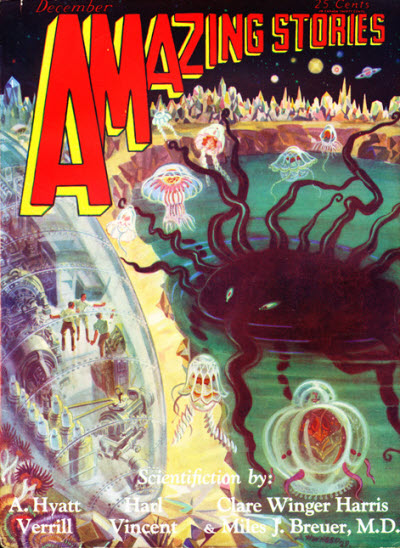 cover by Wesso
cover by Wesso ...From within their warm vessel the travellers gazed out upon
the stern and forbidding character of the landscape without. Directly centered
in their frame of observation was the gently-sloping, plateau-like area that
was midway between a rugged mountain with a cloud-shorn summit and the vast
chasm that Elzar called the sea. Bare, jagged rocks; ice, dry and solid as
rocks; flurries of carbon-dioxide and hydrogen snow — these were printed
indelibly upon their brains as they sat before the infra-red viewing box, and
switched on the current. The two older men calm and silent, the younger man
half hopeful, half fearful, waited for the tuning of the machine. Then,
abruptly, Kuwamoto switched on the amplifying tubes.
Corrigan remarked afterwards that his first impression was
that of looking into a kaleidoscope. Dalton’s impression, again, was that of
looking at an empty room, and suddenly seeing it richly furnished. The
brilliant coloring of the scene took their breath away. The gaunt mountain was
covered with great billows of luxurious vegetation, and the plain was a wealth
of flowers, trees, and grass, all inexpressibly huge in proportion to the
people looking at them. The most beautiful sight of all were the great, opalescent
bodies of varying shapes and sizes that were scattered about the landscape at
varying heights above the ground. Their colors shimmered and flashed throughout
the entire-chromatic scale of visibility.
But, it was only the scintillating of the flashing hues that
gave any variety to the scene, for everything was motionless. Not a movement,
not a stir, anywhere. The immobility of the iridescent, vari-formed objects was
disappointing. It was like a brilliantly colored stereopticon picture.
The three men looked at each other with emotions that cannot
be described. Has anyone tried to picture what Balboa felt when he first saw
the Pacific Ocean from the “peak in Darien”? A few moments of breathless
silence, and then some trivial remark to break the constraint ; that is the way
scientific men take these situations.
“Medusae!” Dalton exclaimed. “Jelly-fish, a thousand times
magnified!”
“And everything frozen solid,” Kuwamoto remarked.
They moved their vessel here and there, to get new views,
watching the scenery on the screen of the infrared view-box. With intense
interest they viewed the multicolored festoons that adorned the landscape;
huge, umbrella-shaped bodies that clung to the hillsides. Exclamations of
delight issued from their lips from time to time, as some amazingly lovely
object came within their range of vision.
“These medusoid forms must be the people — the intelligent
beings,” Corrigan remarked. The others assented.
The vast chasm was now a sea; why it should happen to be a
deep greenish blue is not yet explained; but that was its color. Down in its
depths could be seen vast, gloomy 'bulks'; and on the surface, here and there,
an enormous, slimy bulk, like a gigantic paramecium — obviously the ravenous
beasts that Elzar feared so much. The three observers were hushed for a moment
when they noted the contrast between the repulsive bulks of these beasts, and
the brilliant and delicate tracery of the intelligent inhabitants. They brought
their machine back to their original landing place, after hunting about a few
minutes to find the location.
“Here we are,” Corrigan finally said; “same old place.”
“And yet, not quite the same,” Dalton replied. “Look, some
of these things have moved. They have different positions. Kuwamoto is right.”
It was true; there was a slight change of position
throughout the entire group of huge, globular objects.
“That must be Elzar!” Corrigan pointed with suppressed
excitement to a brilliant umbrella-shaped body in all hues of purple, floating
near a resplendent structure not far from the cliff’s edge.
Kuwamoto nodded. He was busy adjusting the motion-picture
taking machine. He had it trained on Elzar and his house.
“One picture a minute,” he said. “In about six weeks we can
see some action on this film..."
Clare Winger Harris and Miles J Breuer, M.D., A Baby on Neptune (Amazing Stories, December 1929)
>> Guess The World - Sixth Series
Comment from contributor Lone Wolf:
A
curious short story which describes gaseous life on Neptune that exist at a much
slower time-rate, thus their reality being invisible to the normal Earthling's
perceptions. According to the authors the processes on the farther planets
would be slower because of the less energy received from the Sun and vice versa
- thus on Venus for example the life goes faster than on the Earth. Although
not very believable, the idea is fascinating even by contemporary standards.
Comments from Zendexor:
Lone Wolf sent in some further information which is relevant not only to this excerpt but to the next GTW, for reasons which will become obvious when I have put that next one on site. Just for now I will reveal that the above Neptunian scene is said to occur in the year 2347.
Some
time ago I made several attempts to access "A Baby on Neptune" and
failed. I think these internet archive options must come and go in
accordance with some rule or policy. Recently I wanted to look up some
detail in Juve's Monsters of Neptune and found I could no longer
get to it, though I'd had no trouble reading it on the archive while composing
the Neptunian Allure page.







